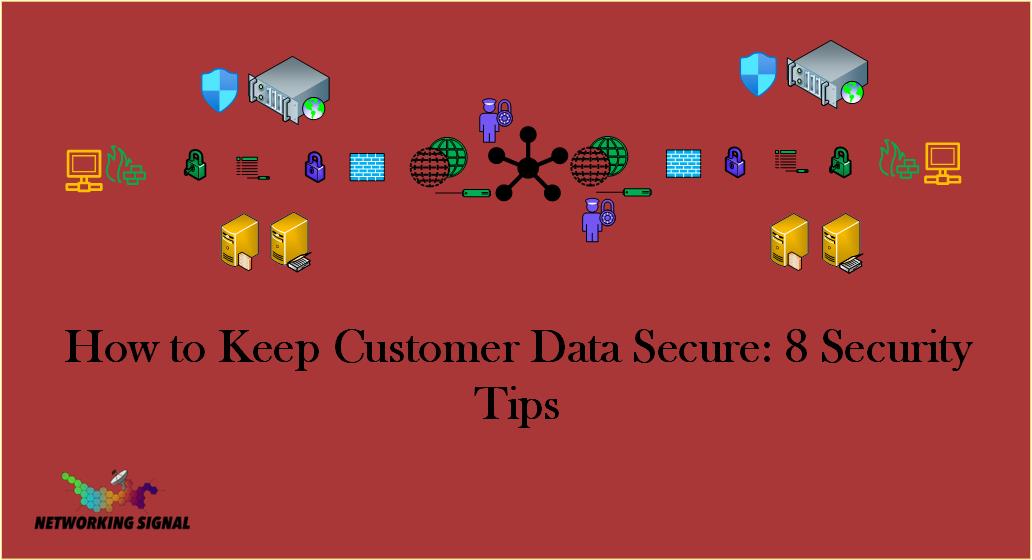Many companies collect customers’ data every time they interact with them. There are many data cyber threat activities related to data where companies pay fines to regulatory bodies, i.e., GDPR and CCPA.
Data breaches are on the rise, and the only thing for companies to do is ensure proper data security. Protecting customer data will improve the consumer’s trust giving your brand a good reputation.
Employers and companies should understand how to protect customers’ data. This guide will discuss different security tips brands can implement to protect customers’ information.
Security Tips to Keep Customer Data Secure

You can use several ways to beat cybercriminals targeting your customer data. Some of the best practices to implement to promote data security are as follows:
1. Implement encryption
Perform encryption for all data in motion and at rest using different encryption methods. The common encryption methods include 256-key bit length and file-level encryption.
It ensures proper data security by providing security to the databases, emails, and the client’s data.
2. Ensure you buy an SSL certificate for all your domains and subdomains
For businesses that manage several websites, applications, and subdomains, ensure you buy and install an SSL certificate on all of them.
It assures the customers that the company has better data security measures, improving the user’s trust.
SSL certificates encrypt all the data making it hard for hackers to access sensitive information.
Examples of certificate authorities from where you can buy SSL certificates. Such authorities include Comodo, SSL.com, DigiCert, Sectigo, AlphaSSL, Entrust, and GlobalSign.
3. Limit employees who can access the data
Companies should implement the principle of least privilege (PoLP) to limit which employers can access data.
It specifies which users can access the company data, which increases data security and eliminates any internal cyber threats.
Permitting many people to access all the user’s data is risky and opens the data to hackers.
Some common methods to implement this include using identity and access management (IAM) tools and providing access to data using job levels, i.e., junior developer, senior developer, etc.
The common permissions include modify, access, full control, and modify and access.
4. Educate all your staff and users
Companies lose their data since sometimes their workers have no idea about data security and cybersecurity.
Educate them on different aspects of cybersecurity, i.e., how to detect a cyber threat, remain vigilant from attacks, and best practices for not being hacked.
It pushes them to understand how to keep the customer’s data safe and how to achieve it.
You can implement this by paying for cybersecurity courses they can take in their free time.
Consider employing cybersecurity experts to help you educate your workers on cyber threats.
Educate the users on how to keep them safe from cybersecurity threats and help them protect their data.
Look Here:
5. Back up all your data
Most cybercriminals use different threats like ransomware to ask for money after having access to your data.
It makes companies get worried and fall for the trap, especially if you store data in one place.
Backups will ease pressure during any data breach and help your company resume operations faster.
There are several online places (like the cloud) where you can safely back up customer data without issues.
Look Here:
6. Update software and plugins
Ensure all the software and plugins the company uses are updated to protect your customer’s data.
Security updates fix any security issues that may exist in the software.
It also ensures you use the latest encryption methods, which gives hackers a hard time accessing customer data.
Using old, outdated software allows cybercriminals to find any loopholes they can use to exploit and steal customers’ data.
For better data security, make it a habit to scan all software to see if there is any pending updates.
For vulnerabilities, there are different tools one can use to check if they exist.
7. Adopting a secure architecture
Use proper architecture for your entire business infrastructure to ensure proper data security. The best ways to have better architecture include:
- Ensure to download and install antivirus and antimalware to protect the data from any viruses and malware cybercriminals transmit. Remember to perform regular scanning to detect any malicious software.
- Install anti-adware and antispyware software.
- Install Endpoint detection software.
- Use of pop-up blockers to block all pop-up ads and notifications.
- Installation of firewalls to provide extra security both to the network and infrastructure.
- Using vulnerability scanners to detect any scanners that may exist in your system.
8. Only collect the required data
When collecting customer data, ensure that it is the information you need
for the process instead of collecting unwanted information.
Collecting the right data saves you from huge losses in a data breach. Companies should conduct data audits to see if the data collected is valuable, if not, they should stop collecting it and delete it if possible.
One can use some software, i.e., Titans, to set expiry periods for
particular files. Implement the KYC framework, where you can use third-
party companies to collect information on your behalf.
Some companies have forms that ask for a lot of personal information, which they do not need, which is a threat to data security.
Conclusion
It’s the role of an employer in a company to ensure proper data security measures to prevent hackers from accessing customers’ data.
There are increased data breaches, and businesses must keep fighting to protect themselves from cyber threats.
If you have a company that lacks security policies, it is the right time to do so by implementing the above measures.

